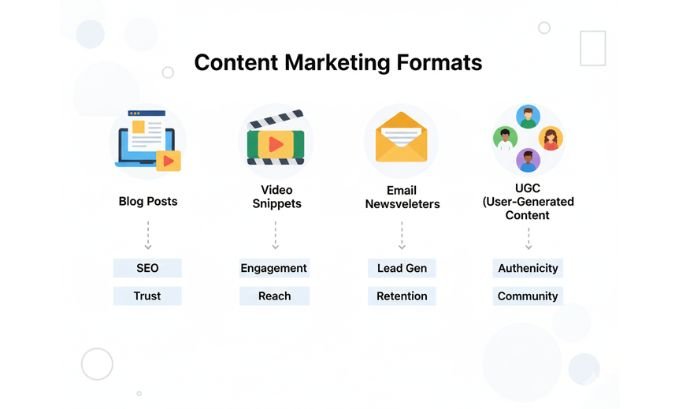Launching a startup often feels like running a marathon barefoot—every dollar counts, and every decision matters. The truth? You don’t need a huge marketing budget to make an impact. What you need is smart, low-cost marketing ideas that stretch your creativity, not your wallet.
In this guide, we’ll explore practical, real-world marketing strategies designed for startups looking to build visibility, attract loyal customers, and grow sustainably — all while keeping costs lean.
Table of Contents
What Are Low-Cost Marketing Ideas for Startups?
Low-cost marketing ideas are creative, resource-efficient methods that help startups reach their target audience without spending heavily on traditional advertising.
Instead of paying for reach, startups focus on value-driven engagement — using tactics like content marketing, social media marketing, and brand positioning to build credibility and awareness organically.
These approaches fit into the broader concept of low-budget marketing, a marketing strategy that emphasizes efficiency, authenticity, and adaptability.
Why Low-Budget Marketing Works for Startups
Startups often don’t compete with established brands on money — they compete on connection and creativity.
When done well, low-budget marketing:
- Builds brand awareness through authentic storytelling.
- Targets the right audience segments efficiently.
- Maximizes marketing ROI by focusing on measurable outcomes.
- Follows the marketing funnel — guiding leads from awareness to conversion through smart, cost-effective content.
In short, it’s about doing more with less — strategically.
The Foundation: Understanding Your Marketing Funnel
Before diving into tactics, let’s revisit the marketing funnel — a critical framework in every marketing strategy.
| Funnel Stage | Objective | Example Low-Cost Tactics |
|---|---|---|
| Awareness | Get noticed | Blog posts, social media videos, SEO, PR outreach |
| Interest | Build curiosity | Lead magnets, educational webinars, storytelling |
| Desire | Create value | Testimonials, case studies, influencer partnerships |
| Action | Drive conversion | Email sequences, limited-time offers, referral programs |
Understanding this customer journey ensures you allocate your efforts and budget strategically.
Step 1: Define and Understand Your Target Audience
Here’s the golden rule — you can’t market effectively if you don’t know who you’re marketing to.
Your target audience is the backbone of your marketing strategy. Define it through:
- Demographics (age, location, gender)
- Psychographics (values, motivations, pain points)
- Behavioral data (purchases, browsing habits)
Example:
A fitness startup might find that its audience isn’t just “people who want to lose weight,” but busy professionals seeking time-efficient health solutions. This insight shapes everything — from your messaging to your choice of marketing channel.
Pro Tip from Adam Erhart (Marketing Expert):
“Great marketing isn’t about convincing people to buy. It’s about connecting with those already looking for what you offer.”
That’s why audience research is step one — not an afterthought.
Step 2: Craft a Strong Brand Positioning on a Budget
Your brand positioning defines how you’re perceived in the market — and perception often matters more than price.
Here’s how to position your brand effectively without overspending:
- Find your niche: Focus on one problem and solve it better than anyone else.
- Create a clear message: Your value proposition should fit in a single sentence.
- Use storytelling: Share your founder story — authenticity builds trust faster than ads.
- Be visually consistent: Use free tools like Canva for branding templates and tone alignment.
Example:
A small coffee brand may position itself as “eco-friendly and community-driven,” appealing to local sustainability-conscious audiences.
Step 3: Master the Art of Content Marketing
Content marketing is the backbone of low-budget growth. It’s not just about creating content — it’s about creating value.
Startups can leverage content to educate, inspire, and convert.

Effective Low-Cost Content Formats
- Blog Posts: Answer customer questions; optimize for SEO.
- User-Generated Content (UGC): Encourage customers to share their experiences.
- Email Newsletters: Use storytelling to build relationships.
- Video Snippets or Reels: Perfect for short attention spans — great ROI on social media.
Example:
A SaaS startup created a weekly newsletter offering “10-Minute Marketing Fixes.”
Result? 5,000+ subscribers and 200 demo signups — all organically.
What I Like:
- Builds long-term visibility.
- Improves marketing ROI over time.
- Boosts authority through thought leadership.
Area for Improvement:
- Takes time to build traction.
- Requires consistency and patience.
Step 4: Leverage Social Media Marketing (Organic First!)
Social media marketing is one of the most powerful low-cost marketing ideas for startups. It’s free to start, personal, and scalable.
Low-Cost Tactics That Work:
- Consistency beats quantity: Post regularly using a content calendar.
- Engage with comments and DMs: Builds community and trust.
- Use trending sounds/reels: Free reach on TikTok and Instagram.
- Collaborate with micro-influencers: Often cheaper and more authentic than big names.
Example:
A skincare startup collaborated with 20 micro-influencers on Instagram. Total spend? Under $500.
Outcome: 10x increase in followers and 3x sales boost within a month.
What I Like:
- Direct communication with your audience.
- Real-time engagement and feedback.
- Amplifies brand personality and human connection.
Areas for Improvement:
- Algorithm changes can reduce reach.
- Requires consistent creativity and time.
Startups looking to scale in international markets can explore Japan’s thriving e-commerce scene through TokyoMart.store or boost their digital presence with expert help from LinkLuminous.com, a results-driven marketing agency.
Step 5: SEO and Blogging — Your Long-Term Growth Engine
SEO isn’t free — it’s earned. But it’s one of the best low-cost marketing ideas for startups when done right.

Focus on:
- Long-tail keywords that reflect intent (“best productivity tools for freelancers”).
- On-page optimization (titles, meta descriptions, internal linking).
- Entity-based SEO: Incorporate concepts like marketing funnel, marketing strategy, and customer journey naturally throughout your content.
Why It Works:
Organic search traffic compounds over time. You’re building digital real estate that keeps bringing in visitors — without paying for ads.
Tools to Help (Free or Low-Cost):
- Google Keyword Planner
- Ubersuggest
- RankMath / Yoast for on-page SEO
Step 6: Build an Email Marketing System
Email is still king — even in 2025.
Use it to nurture leads, share content, and guide customers through the customer journey.
How to Start on a Budget:
- Use tools like Mailchimp, Brevo, or ConvertKit (free tiers available).
- Offer a lead magnet (e.g., checklist, guide, or mini-course).
- Segment by interest and stage of the marketing funnel.
- Automate follow-ups using triggers.
Example:
A productivity app startup used a free eBook on “Morning Routines for Focus.”
Result: 2,000 new subscribers and 12% conversion rate on paid plans.
Step 7: Tap into Community and Partnership Marketing
Networking doesn’t cost money — it costs effort.
Join communities relevant to your niche on:
- Slack groups
- Facebook communities
- Local entrepreneur events
Partner with non-competing startups for joint campaigns.
Example: A food delivery app partnered with local gyms for “Healthy Meal Mondays.”
Cost? $0.
Result? Shared audiences and mutual growth.
Step 8: Track Marketing ROI to Refine Your Strategy

Even in low-budget marketing, data is everything.
Marketing ROI (Return on Investment) tells you which activities drive the best outcomes.
| Metric | Why It Matters | Tools |
|---|---|---|
| Website Traffic | Measures brand visibility | Google Analytics, Plausible |
| Conversion Rate | Tracks funnel performance | Hotjar, Google Optimize |
| CAC (Customer Acquisition Cost) | Keeps cost efficiency in check | HubSpot, Notion CRM |
| LTV (Customer Lifetime Value) | Ensures long-term profitability | Stripe, Baremetrics |
Focus on continuous optimization — low-cost doesn’t mean low-quality.
If you want more information about low-cost marketing ideas for startups, you can visit these sites Mind Journal and Go! Go! Nihon
Case Study: How a Startup Grew 300% with Low-Budget Marketing
Startup: EcoThreads — a sustainable clothing brand.
Challenge: Competing with large eco-brands on a tight budget.
Strategy:
- Focused on content marketing and social proof.
- Used Instagram Reels and UGC to showcase products.
- Partnered with a micro-influencer who shared their sustainability mission.
Outcome: - 3x growth in 6 months.
- Marketing ROI of 420%.
- Recognized by a local business magazine for brand authenticity.
This real-world example shows that low-budget marketing is less about money and more about message and execution.
Comparison Table: Paid vs. Low-Cost Marketing
| Aspect | Paid Marketing | Low-Cost Marketing |
|---|---|---|
| Budget Need | High | Minimal |
| Speed | Fast | Gradual |
| Sustainability | Short-term | Long-term |
| Engagement | Transactional | Relationship-based |
| ROI | Declines over time | Grows over time |
FAQ: Low-Cost Marketing Ideas for Startups
Q1. What are the best low-cost marketing ideas for startups?
A: Focus on content marketing, social media engagement, SEO blogging, partnerships, and community building.
Q2. How can startups measure marketing ROI effectively?
A: Track metrics like conversion rates, CAC, and customer lifetime value using tools like Google Analytics and HubSpot.
Q3. Is social media marketing better than paid ads for startups?
A: For most startups, organic social media offers better engagement and brand building early on. Paid ads can follow once you validate your message.
Q4. How long does low-cost marketing take to show results?
A: Typically 3–6 months, depending on consistency and channel mix. Organic marketing compounds with time.
Q5. How can I find my target audience on a small budget?
A: Use free analytics tools, surveys, and social listening on platforms like Reddit or X (Twitter).
Q6. Who is Adam Erhart, and why is he relevant?
A: Adam Erhart is a respected marketing strategist known for practical, cost-efficient frameworks for small businesses — ideal for startups.
Q7. What’s one mistake startups make with low-budget marketing?
A: Trying to be everywhere at once. Instead, focus on one or two high-impact channels first.
Conclusion: Building Growth Through Smart, Low-Budget Marketing
The secret to success in low-cost marketing for startups isn’t cutting corners — it’s maximizing creativity and strategy.
By understanding your target audience, mapping your customer journey, and using tools like content marketing, social media, and email, you can grow organically while staying lean.
Remember: marketing isn’t about spending more — it’s about connecting better.
So start small. Be consistent. Measure results.
And watch your startup scale — sustainabl
Author Bio
Digital marketing strategist and startup growth consultant with over 8 years of experience helping early-stage founders scale using low-cost, high-impact marketing strategies. Inspired by frameworks from Adam Erhart, this article is built on real-world insights, data-driven results, and actionable steps for modern entrepreneurs.


